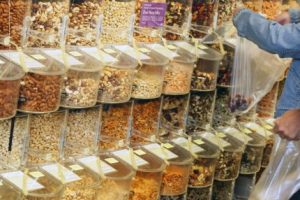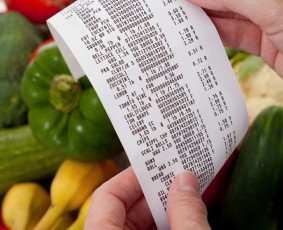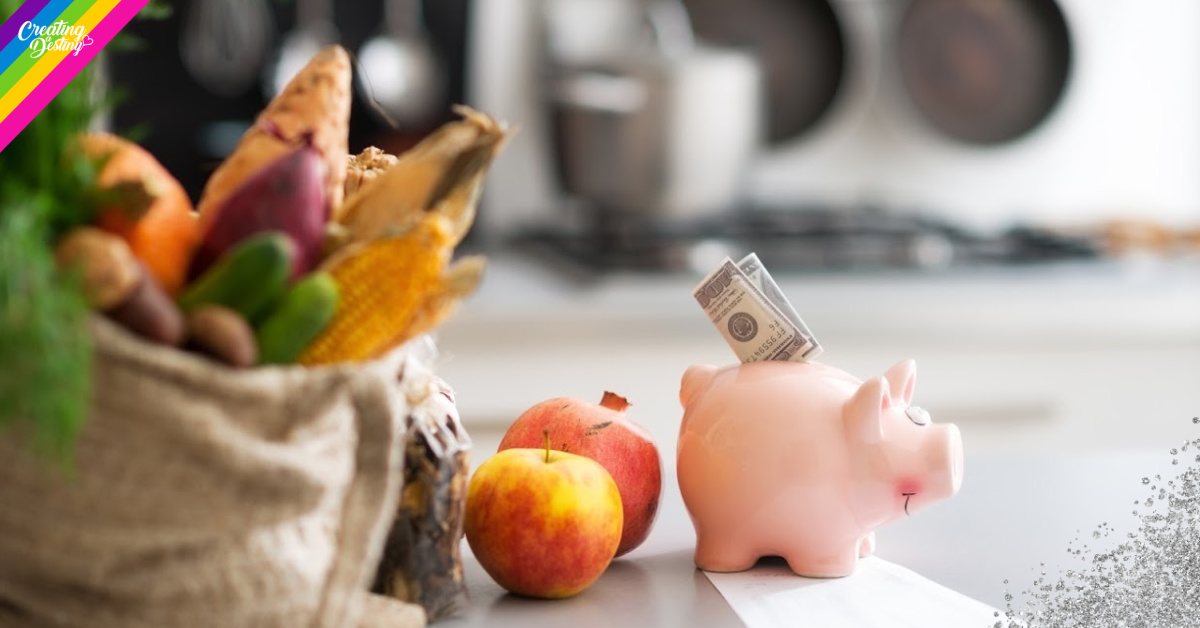The biggest myth I have found in my healthy journey, is that eating healthy is expensive. Listening to thousands of clients over the years, I have learned that most people just don’t know how to plan, grocery shop, and prep their food, in a budget conscious way. This leads to a lot of buying of things they don’t need, forgetting things they do need, and food going bad. That can be really defeating and overwhelming. They key is to save money on groceries from the start.
People also rarely take a look at their bank accounts, and actually add up ALL of the money they have spent on eating out, snacks at the gas station, breakfast sandwiches on the go, hot lunch at school, vending machines, ordering a pizza, and so on.
I always recommend looking back over a rolling 30 days and adding up the whole family’s expenses on these little things that happen as a result of not having a healthy plan in place. I have heard numbers as high as $500! People are shocked. Talk about it being expensive to eat UNHEALTHY!
There is a way to feed your family healthy food, without breaking the bank. I included my top 10 tips below, and I want to note, you will NOT see “coupons” on my list. In my personal experience, if it has a coupon, it’s not all that healthy. There aren’t a lot of coupons out there for apples and carrots lol, plus you already know about coupons, so no need to get into that.
We will talk about sales though, and that is a bit different. I hope you find these helpful!
10 Step Guide to Save Money While Eating Healthy
 1 – Eat for the Season: We are very spoiled here in The States. Fruits and vegetables are readily available, even when they aren’t in season. While you can get these items virtually any time, you often pay a high premium, for a lesser quality food. Think about strawberries. Strawberries at the end of summer are so sweet and perfect, and the stores can’t give them away fast enough. By the end of August you can get pounds of berries for a few dollars. It’s because they are in season!
1 – Eat for the Season: We are very spoiled here in The States. Fruits and vegetables are readily available, even when they aren’t in season. While you can get these items virtually any time, you often pay a high premium, for a lesser quality food. Think about strawberries. Strawberries at the end of summer are so sweet and perfect, and the stores can’t give them away fast enough. By the end of August you can get pounds of berries for a few dollars. It’s because they are in season!
Those same strawberries might cost 5x the amount in January and they don’t have that soft sweetness. If you become a creature of habit, and go off how you feel instead of what you know, you will spend more money in January, just because you feel like strawberries. There are other things you can eat then, that will save you a ton. One of my favorite sites is Seasonal Food Guide, because it lets you put in your specific location, and it tells you what in season local to you!
2 – Know How Much Things Cost: This may seem silly, but honestly I started shopping for healthy food and I was completely clueless. What is a good price for chicken breast? No idea? How much should celery cost? Beats me. THIS MATTERS! If I don’t know that I can get smaller Fuji apples for $0.57 a pound, and I buy the bigger fancier Pink Lady ones for $1.10, that is going to add up when I decide to get 7 of them, right?
If I am just tossing in my ground beef, at the normal $9.99 a pound for grass fed organic (yes did you just die, I did for when I typed that, so expensive lol), I could totally miss that the value pack at Sprouts was $3.99 for grass fed this week. If we just blindly keep buying the same things because that is all we know to buy, and we don’t compare, and learn, it really ads up over time. It has taken me years to know what a good deal is off the top of my head, but it started with simply PAYING ATTENTION. Now my husband gets excited text messages about things being $3.00 off lol. It’s cheaper to pay attention than to pay for over priced food.
3 – Review Your Store Ads: I love that the ads come out on Wednesday. Do you know when your grocery ads come in the mail? I have lived in 4 states and they all came on Wednesday. That  gives me plenty of time to make a plan! I can figure out what meats are on sale, which I often base my meals around, and then see what veggies, fruits, etc. I can start to form my meal plan in my head, and start to think of ideas, explore Pinterest for recipes, and ask the family if they have any dishes they request for the next week. It’s not about what I want as much as what is available at a savings.
gives me plenty of time to make a plan! I can figure out what meats are on sale, which I often base my meals around, and then see what veggies, fruits, etc. I can start to form my meal plan in my head, and start to think of ideas, explore Pinterest for recipes, and ask the family if they have any dishes they request for the next week. It’s not about what I want as much as what is available at a savings.
4 – Make a Plan: Now that you know what is in season, and you know what is on sale, you can sketch out a meal plan for your family. Figure out what you want for each meal, and how many servings you need, so you know how much to buy. If you have an idea of what you actually need, you won’t end up with too much of one thing, and not enough of other. It also keeps you focused at the store because from the plan, you can make a list.
Going to make dinner and realizing you need something else usually just ends in a phone call to tell your other half to drive through some place on their way home. If you have everything you need you are more likely to cook. Plus, if you know what you are going to cook, you don’t have to think about it and decide. If you have never made a meal plan before, consider checking out the site Learn to Meal Plan for step by step info.
5 – Never Shop Without a List: We’ve all gotten home from the store to realize we forgot something right? So frustrating. Now the other 6 things for that recipe will either get wasted or you have to go back to the store, which you swear you will do, but you may not.
 Having a list also keeps the random extras from being thrown into your cart. Well unless you take your kids with you, then good luck 😛 But seriously, how many times have you impulse bought something at the store and gone over budget? A list is very helpful.
Having a list also keeps the random extras from being thrown into your cart. Well unless you take your kids with you, then good luck 😛 But seriously, how many times have you impulse bought something at the store and gone over budget? A list is very helpful.
In order to make an effective list, you need to have at least a rough plan on what you want to eat for the week. Breakfast, snacks, lunch dinner…what does it look like? Who all are you feeding? How much of everything to you need. Make a list!
Part two is to then bring said list to the store and actually use it. I like to sort mine by how the store is laid out in my head. It makes it so I don’t have to go back and forth and waste time, and I don’t miss anything. If they don’t have something on your list, have some alternatives in mind. If you know you want to have fruit with your lunch, but grapes are unusually expensive, or out of stock, but you see honeydew melon is only $1 right now, swap it!
6 – Know What’s in Your Kitchen: This is a step that most people I speak with have never even considered. Yet we’ve all come home with a dozen eggs, only to realize we already have a dozen eggs, and now everyone has to have eggs for dinner tonight.
Once I make my list I go into my kitchen and “shop”. I cross out, or alter quantities, of things that are already in my home. Making a soup that requires diced tomatoes but I have a can already? Cross it off! No point in hoarding canned tomatoes in my cupboard. If I see any place I can make a tweak, or swap out something I have at home, I do. I get my list pared down as much as possible.
7 – Think of Multiple Uses for Foods: A lot of times eating healthy means trying new recipes. I don’t suggest trying ALL new recipes every week. If you try 2 new dinners this week, you will most likely have extra of something, since there is rarely the exact amount you need. Maybe you need celery for a soup, but you will have left overs. Do you have a favorite chicken or tuna salad you can make for the rest? When you have a purpose for every ingredient that comers home with you, they will not go to waste.
It’s simply important to think ahead and be intentional with what you are purchasing. Not sure what to make with the extra stuff? Check out My Fridge Food and put in what you have. It will give you recipe suggestions based on the ingredients!
8 – Bulk Foods, Two Ways: When you see “bulk foods” your mind may go immediately to buying food in bulk. These can be your club stores, like Costco or Sams Club, where you can get a lot  of things you need at once, or purchasing your meat for the year directly from a farm, etc. I am not against those ideas, if you will actually use the items. If you can’t walk into a Costco without buying every single item they are offering samples for, plus two kids outfits from the middle section, and pizza from the food court, bulk shopping is not for you 😉
of things you need at once, or purchasing your meat for the year directly from a farm, etc. I am not against those ideas, if you will actually use the items. If you can’t walk into a Costco without buying every single item they are offering samples for, plus two kids outfits from the middle section, and pizza from the food court, bulk shopping is not for you 😉
Another bulk foods option, that is underutilized, is the food area of the store where you measure out what you need. Trying a recipe that calls for 1 teaspoon of something? No need to spend $8.00 on a jar of spices when you can pay $0.10 in the bulk section. Same goes for nuts, raisins, flour, whey protein, grains, snacks, and more. Often times you are simply paying for packaging, or you are getting way more than you need, and wasting money on something you won’t use again.
9 – Eat the Same Thing Throughout Your Week: I have tested this every which way, and repeating breakfasts, snacks, and lunches, saves money. There is no way around it. If you pick a few lunches you love, and rotate, that works too. It is cheaper to buy 1 thing 7 times, than 7 different things, because of the way things are packaged. 1 dozen eggs, 1 box of cereal, 7 yogurts, etc is going to cost less than buying ALL of those things.
Not only that, but you have something you can count on, the decision is easy, you don’t have to think about what to make (especially time saving for breakfast) so you can make it and go! When we have to think about something too much, we often skip it all together and find ourselves eating a breakfast sandwich at Starbucks when we have perfectly good food at home.
I always say do change things up at dinner, so you don’t get bored, and you enjoy your food, but sticking to easy and predictable the rest of the time really can save you a lot of money. We have so much to do already, thinking about what to make for lunch shouldn’t have to be on your mind!
10 – Freeze Things for Later: Contrary to popular belief, the freezer is not just to hold frozen pizza and ice cream. It is great for so many things I’ve mentioned above. More strawberries than you can possible eat? Freeze them! Onions about to go bad? Dice and freeze! The crock-pot soup you made was too many servings? Great, freeze them and now you have 2 lunches next week you don’t have to buy! Have a chance to buy those meats in bulk? Awesome, right into the freezer.
Remember to check your freezer each week BEFORE you go shopping. Saving money on meats has been huge for us, as well as frozen fruit for our breakfast shakes, and frozen onion save so much time! Checking those off your list before you head to the store will mean a lower total at the checkout.
 Bonus Tip – Don’t Go “All In” Too Quickly: You guys listen to me on this one. I tried to do a Whole 30 once when I had NEVER eaten Paleo. I am not kidding you I think I spent over double our monthly grocery budget, which at the time may have been close to rent. I was shocked and discouraged. The problem was I went ALL IN. Changing everything we ate meant new condiments, new spices, new staple foods, new flours, and new new new.
Bonus Tip – Don’t Go “All In” Too Quickly: You guys listen to me on this one. I tried to do a Whole 30 once when I had NEVER eaten Paleo. I am not kidding you I think I spent over double our monthly grocery budget, which at the time may have been close to rent. I was shocked and discouraged. The problem was I went ALL IN. Changing everything we ate meant new condiments, new spices, new staple foods, new flours, and new new new.
Something that might last 3 months can be costly, and when you buy a ton of those, it really ads up. Trying one or two new things a week is way more manageable. Getting a small amount of something before you decide if you are going to use it is great! Drastic changes are going to mean drastic amounts of money spent, so consider that before you go “all in” on things!
I hope you found this money saving grocery guide helpful and I am always here if you have any questions at all!
—
Thank you,
Coach Amber Snow
619.567.4779
*As Your Coach, I am Here to Believe in You Until You are Strong Enough to Believe in Yourself <3 *

